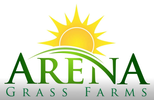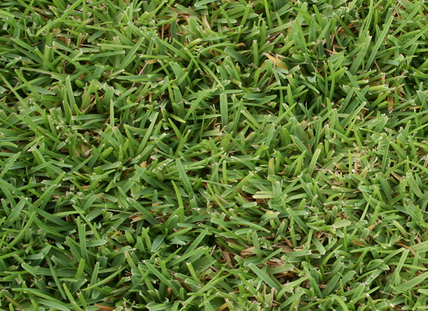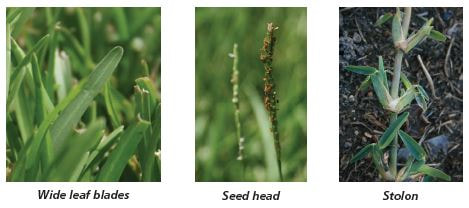Centipede Grass in Louisiana
Description
Centipede grass is a common warm-season turfgrass grown in Louisiana. It is popular among homeowners because of its low maintenance requirements. It is also favored because of its ability to grow in warm weather and acid soils with low nitrogen fertility. Centipede grass is slow growing and spreads through stolons (aboveground stems). It can be established via seed, plugs or sod.
Identification
Centipede grass is a medium-textured turfgrass with sharply creased, bright green leaves. Leaves are alternately arranged on the stolon and have a narrow, rounded tip. Centipede grass has slender singular seed heads, which extend slightly above the leaf blades and produce small white flowers. It produces stolons (aboveground stems), which allows it to spread laterally.
Hint: Centipede grass can be confused with St. Augustine grass and carpetgrass. Note that centipede grass has narrow, alternately arranged leaves compared to St. Augustine grass which has wide, oppositely arranged leaves and carpetgrass which has multiple spikes per seed head.
Growing Conditions
Soil Type: Grows in various soil types where there is little compaction, good drainage and low nitrogen fertility.
Soil pH: Prefers acidic (< pH 7) soils, ideally between 5 and 6. If soil is too basic (> pH 7), leaves can yellow. Always follow soil test recommendations to achieve desired soil pH.
Light: Preforms best in full sun. Can tolerate light shade but will decline in heavily shaded areas.
Growth Rate: Grows slowly and spreads via stolons.
Maintenance Requirements
Mowing and Traffic: Mow at 1 to 2 inches routinely during the growing season. Never remove more than one-third of the leaf blade height at one mowing. Mowing at the appropriate height is key in preventing scalping and reducing weed encroachment. Increased traffic causes soil compaction that leads to centipede grass stress expressed as purple to red leaves.
Fertilization: Fertilize with up to 1 pound of nitrogen per 1,000 square feet per year. Fertilizer should be applied from midspring to midsummer. Never apply more than 1 pound of nitrogen per 1,000 square feet per application. Follow soil test recommendations for proper fertility.
Irrigation: Naturally occurring rainfall may provide sufficient water for maintaining a healthy turfgrass in normal years, but irrigation may need to be applied to prevent plant water stress during drought periods.
Dethatching and Aeration: Thatch can develop over time and may need to be reduced through vertical mowing. Compaction can form more quickly on finer-textured soils and in areas where there is high traffic. Dethatching or aeration need to be performed in late spring to summer.
Establishment Methods
Establishing centipede grass in the lawn can be achieved via seed, plugs or sod. Sodding is the most commonly used method for centipede grass establishment.
Seed: Select and purchase your desired seed and follow the manufacturer’s labeled directions for the rate of seed per area. Rake seeds into a smooth soil surface and keep watered until germination and throughout establishment.
Plugs: Purchase plugs or create plugs from sod and plant each piece about 1 foot apart. Irrigate, fertilize, and apply weed control as necessary until established. Plugs are primarily are used for establishing smaller areas.
Sod: Purchase sod and lay it on a smooth soil surface. Irrigate frequently after laying sod and continue to irrigate as needed until sod roots are established.
Centipede grass is a common warm-season turfgrass grown in Louisiana. It is popular among homeowners because of its low maintenance requirements. It is also favored because of its ability to grow in warm weather and acid soils with low nitrogen fertility. Centipede grass is slow growing and spreads through stolons (aboveground stems). It can be established via seed, plugs or sod.
Identification
Centipede grass is a medium-textured turfgrass with sharply creased, bright green leaves. Leaves are alternately arranged on the stolon and have a narrow, rounded tip. Centipede grass has slender singular seed heads, which extend slightly above the leaf blades and produce small white flowers. It produces stolons (aboveground stems), which allows it to spread laterally.
Hint: Centipede grass can be confused with St. Augustine grass and carpetgrass. Note that centipede grass has narrow, alternately arranged leaves compared to St. Augustine grass which has wide, oppositely arranged leaves and carpetgrass which has multiple spikes per seed head.
Growing Conditions
Soil Type: Grows in various soil types where there is little compaction, good drainage and low nitrogen fertility.
Soil pH: Prefers acidic (< pH 7) soils, ideally between 5 and 6. If soil is too basic (> pH 7), leaves can yellow. Always follow soil test recommendations to achieve desired soil pH.
Light: Preforms best in full sun. Can tolerate light shade but will decline in heavily shaded areas.
Growth Rate: Grows slowly and spreads via stolons.
Maintenance Requirements
Mowing and Traffic: Mow at 1 to 2 inches routinely during the growing season. Never remove more than one-third of the leaf blade height at one mowing. Mowing at the appropriate height is key in preventing scalping and reducing weed encroachment. Increased traffic causes soil compaction that leads to centipede grass stress expressed as purple to red leaves.
Fertilization: Fertilize with up to 1 pound of nitrogen per 1,000 square feet per year. Fertilizer should be applied from midspring to midsummer. Never apply more than 1 pound of nitrogen per 1,000 square feet per application. Follow soil test recommendations for proper fertility.
Irrigation: Naturally occurring rainfall may provide sufficient water for maintaining a healthy turfgrass in normal years, but irrigation may need to be applied to prevent plant water stress during drought periods.
Dethatching and Aeration: Thatch can develop over time and may need to be reduced through vertical mowing. Compaction can form more quickly on finer-textured soils and in areas where there is high traffic. Dethatching or aeration need to be performed in late spring to summer.
Establishment Methods
Establishing centipede grass in the lawn can be achieved via seed, plugs or sod. Sodding is the most commonly used method for centipede grass establishment.
Seed: Select and purchase your desired seed and follow the manufacturer’s labeled directions for the rate of seed per area. Rake seeds into a smooth soil surface and keep watered until germination and throughout establishment.
Plugs: Purchase plugs or create plugs from sod and plant each piece about 1 foot apart. Irrigate, fertilize, and apply weed control as necessary until established. Plugs are primarily are used for establishing smaller areas.
Sod: Purchase sod and lay it on a smooth soil surface. Irrigate frequently after laying sod and continue to irrigate as needed until sod roots are established.
Centipede Sod in Louisiana
Arena Grass Farms 1 (888) 788-1448 682 Maraist Rd, Crowley, LA 70526


